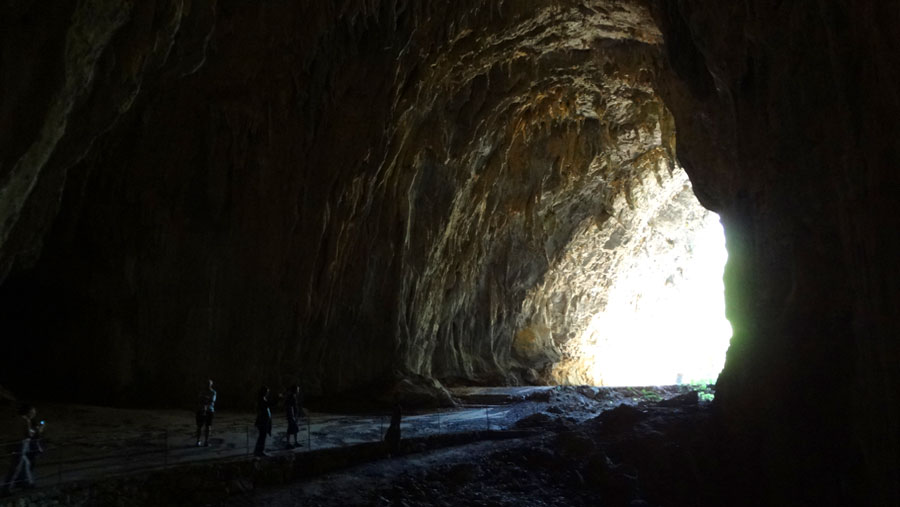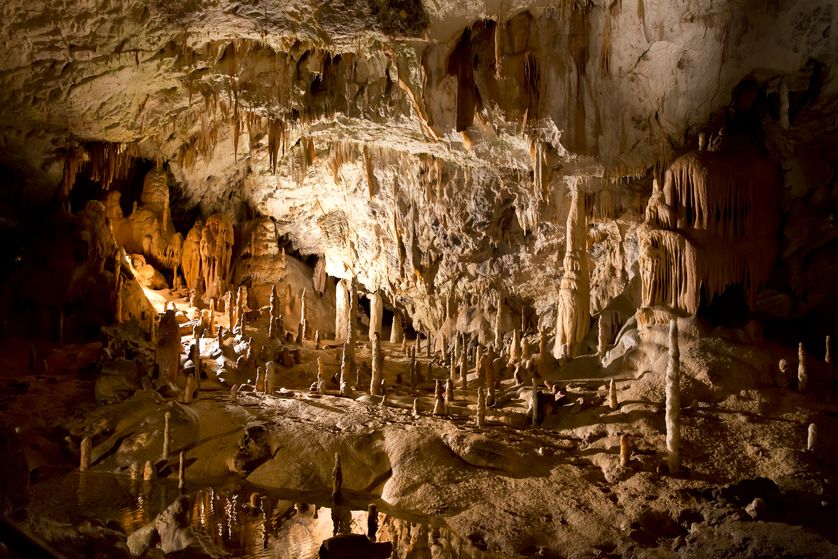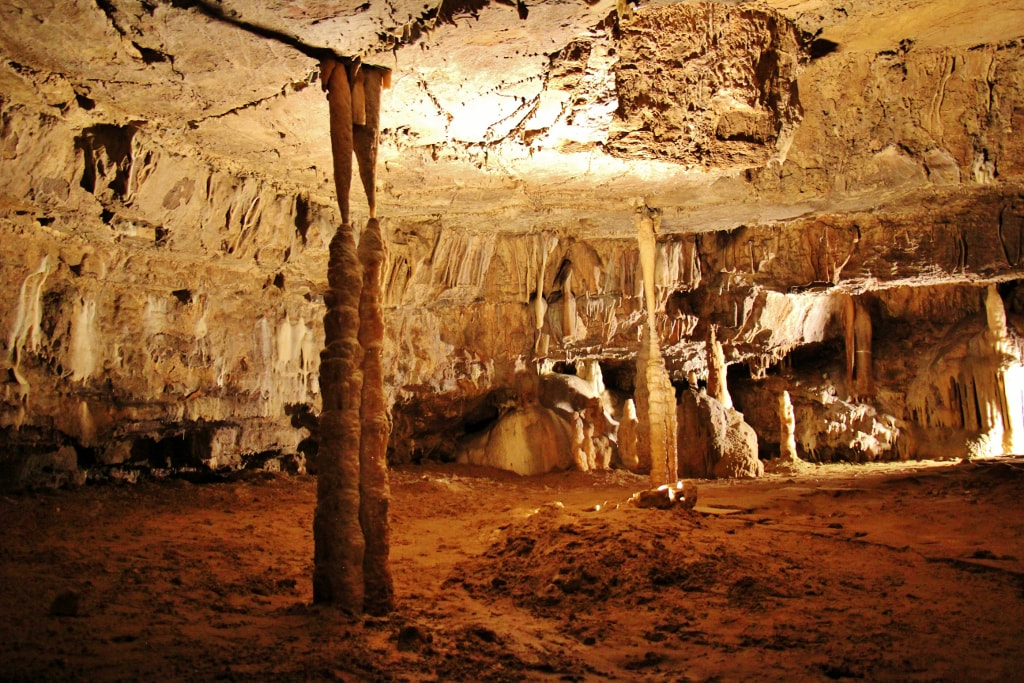|
The Moaning Cavern (cont.) The first installment is here: https://www.secretsofblackmoor.com/blog/quick-and-dirty-disposable-dungeons-part-5-the-moaning-cavern In the previous discussion I left off after having provided a bit of info about possible events that may occur on the way to the moaning cavern. There is a bit of a problem with how all of that is written up. It is beginning to look and read like a commercial module, which to me is too much of a railroad. If you've never heard the term, it is used by gamers to describe an adventure that is set up as a sequence of events that players must deal with one after another. If I was running this adventure for my group. I might have made up the charts in short hand. Everything else would just be a simple entry in the same way we did it back in the day. The troll encounter would only say - 5 trolls. That's it. I would make a mental note of how these trolls will behave, but the rest would not be there. With the advent of commercial modules back in the 70's, Game Masters began to assume they had to write everything up exactly like they saw it appear in published modules, or, heaven forbid, they aren't doing it right! Well, I have news for you. The RPG police are not going to be showing up at your game session to tell you that you are a bad referee and hand you a summons to gamer court. In fact, if you play using crib notes, you are actually playing the way the greatest DM's in RPG history ran their games. Everything was noted in brief, sometimes on 3x5 cards, yet the encounters would come to life and evolve right in the moment as the situation was being played. Of course a referee should always be fair to their players, but I will let you in on another secret, often a really good idea for how to make an encounter better can pop into the referee's head in the middle of a game session. I will improvise about half of my encounters right on the spot if it feels like I can make the game better. You learn to watch your players for cues as to what is really working for them and you follow their lead. One of my truisms that I abide by as a referee is this: A referee must present a game experience that seems fair to players, thus the rules, often made up by the referee, yes, in the old days we'd just make up rules on the spot, have to be fair. The same goes for rulings. Rulings also must be fair. You cannot say bang you're dead, but rather, if you want to do X you will have Y chance of success. Always make players back up a second when they say they want to do something dangerous and state their odds. Then you can also negotiate with the player. More importantly, a referee cannot be bound by a rigid adherence to the planned story, or adventure. A referee should always have the freedom to flex their creative muscle and alter or expand on anything. Why? Because the referee is God! Now lets turn to some other concepts that are worth exploring. First off, how many encounters should any area contain? Unless you are creating a mega-dungeon where you want to have hundreds of interconnected room and passage encounters this kind of adventure should only have around 8-12 'keyed' encounters. Your players will take any single situation and it can end up being played for one minute up to an hour. I had an entirely ad-libbed dream sequence at the inn turn into about 90 minutes of fun without a single die roll. You can't predict what your players will do, or how long it will take. Ref's who make up campaigns want to give the players a bit of the taste of a location within our worlds, but we also want to keep them moving through our world settings and our grand arc stories. Thus a single location like this cave complex needs to be simple and you only want a handful of encounters. I want this game to be limited to perhaps 2-3 game sessions and I know that more than 10 situations will turn this one game into several months worth of sessions, so I am going to create several interesting things to explore. Some of my encounters are hidden chambers. It players do not find the hidden chambers, I will take the ideas and put them in another dungeon. I collect my ideas and I keep them in lists, thus my creative energy is not wasted. Don't fudge die rolls, if the players miss their chance to see something you can re-use it later. I haven't bothered to draw up a map. I really need to do that. Here are some other locations for my adventure.
The Left Hand Passage While the main cave may be a little damp, things are about to get colder and wetter as the players enter this side passage. They will not have been told that The Moaning Cavern is actually just the first step into a series of caves. These are very old and were carved out of the lime stone mountains eons ago by an underground river tha has since shifted is course. Did I mention wet and cold? Make sure to describe how dripping sounds echo through this place. This section leads downward. Roughly a hundred feet farther in the players will encounter an area that is lit up by a magical glow. The glow comes from several pairs of stones that have been implanted in the ceiling. Did I mention this tunnel is large. At this point it will widen out to about 70 feet across and the these stones are roughly 60 feet above the players. The stones have been here a long time. This is goblin magic. Goblins do not cast spells, they imbue gems with magic and cast gems. In this case it's a simple light spell that is activated when two gems are placed next to each other. If a player can figure a way to get to the ceiling, they could pry these gems out and keep them. As a side note. Dwarves are always enchanted and pleased to find ancient goblin spell gems. Elves will want to destroy them. This poses a problem for mixed parties. Dwarves see elves as a bit prissy and not to be trusted, in fact in dwarf language they refer to elves as The Traitors. Elves are not fond of dwarves and think of them as obsequious and hairy little runts. Dwarves can be incredibly charming. Foggy Cross Roads At this point the tunnel will be full of a fog so thick that everything the players own will get damp. This place is mildly haunted and voices can be heard whispering, along with the ever present dripping sounds that can be heard in this cave complex. These voices come from every direction. Sometimes they will make clear statements such as: -come over here -no one can save you -the warrior wants your cloak -you are all alone Get creative with this paranoia inducing information. You can even hand slips of paper with notes on them to individual players. Maybe one of the players will see and feel something like a hand come out of the fog and brush across their arm. I like to stand and wander around the room as I describe these things and actually brush my hand across a player's shoulders. This place is creepy. On a 1 on a D6 a random player will be 'handed' a glowing gold bauble. No other player will see this. This is a curse. The player is allowed to decide whether to grasp the object when it is handed to them out of the mist, or let it drop to the ground. If it drops it will be lost in the mist. A cursed player will immediately hear a voice that says, "I am yours and yours alone." It will guide the player to keep the bauble hidden and only speak to it in whispers so no one else can hear. The player will be told that they can now read other creatures minds. All of the E.S.P. is a trick. And once cursed, this will not go away without the intervention of clerical magic. The player should not desire to be cured. Perhaps the player will become aware that the thief player wants to steal their bauble. Yet there is no bauble. It's all in the player's head! The players will not be aware that this cross roads will magically re-orient the party to walk one of the four directions. In fact, they won't even see an intersection. A dwarf may notice something changed after leaving the fog. "Hmmm… we were heading north and now we're headin' east - Something ain't right here!" Give your dwarf players a 1-2 on a D6 chance to note the change. Also, If the players do not stay within sight of each other, it is possible for the party to get split up here. Still Water This cave has a strange anomaly in it. A pillar of still water comes up out of a hole in the floor and reaches all the way to the ceiling. Describe this as a pillar made of a glassy watery substance. You can stick your hand in this water and it comes out dry. Even a torch stays lit when placed into this wall of water. In fact, you can step into it and you will not drown, but your movement will be like someone swimming through water. If you want to, you can swim down and after a drop of about 100' feet you will appear in a lower cave where you can step out into another tunnel Any wandering monsters that appear while you are here, are just as likely to come into the room via the water as through one of the passages. As always, once I get to rambling about something I can't stop. I seem to have missed talking about the scale of one's maps. This also relates to the original Blackmoor Dungeon. I also need to talk about wandering monsters and how players cannot fully rest while underground. The cave images come from two separate cave complexes in Slovenia. I was lucky enough to visit one of them. It really changed my perspective on natural caves. Caverns are like an underworld wilderness setting. Until next time... Support Secrets of Blackmoor, check out our store for goodies: store.secretsofblackmoor.com/
0 Comments
Leave a Reply. |
DVD'S, Books, T-shirts, games and more available on our store.
AuthorSecrets of Blackmoor is a Feature-length documentary about the birth of the “Mother of all Games;” Dungeons & Dragons. Archives
January 2024
Categories |
Privacy Policy
All Contents Copyright © 2023 The Fellowship of the Thing, Ltd. - All Rights Reserved
All Contents Copyright © 2023 The Fellowship of the Thing, Ltd. - All Rights Reserved




 RSS Feed
RSS Feed